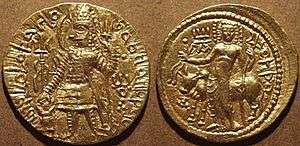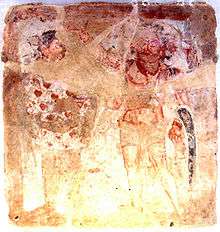Oesho

Oesho was a deity represented on the coins of several Kushan kings, and was apparently one of the titular deities of the dynasty.
The deity is often thought to be identical with Shiva (I'sha), and "Oesho" would just be the pronunciation of Shiva's name in the Bactrian language of the Kushans.[2][3] The deity is shown to depict him holding a Trishul or Trident with a Bull often identified with Nandi.[4]
However, the images were previously though to represent Shiva, but recent studies indicate that Oesho was Zoroastrian Vayu with admittedly many of the attributes of Shiva (H.Humbach, 1975, p. 402-408. K.Tanabe, 1997, p. 277, M.Carter, 1995, p. 152. J.Cribb, 1997, p. 40. References cited in "De l'Indus à l'Oxus".)
But again the coins of Vasudeva I, who converted to Hinduism, continue to depict, the deity, has left open the discussion, weather Oesho is Shiva or Vata-Vayu.
Notes
- ↑ Metropolitan Museum of Art exhibition
- ↑ The Dynasty Arts of the Kushans. University of California Press. 1967. pp. 92–93.
- ↑ Blurton, T. Richard (1993). Hindu Art. Harvard University Press. p. 84. ISBN 0-674-39189-6.
- ↑ Coins of Vima Kadphises
References
- Bopearachchi, Osmund (2003). De l'Indus à l'Oxus, Archéologie de l'Asie Centrale (in French). Lattes: Association imago-musée de Lattes. ISBN 2-9516679-2-2.
